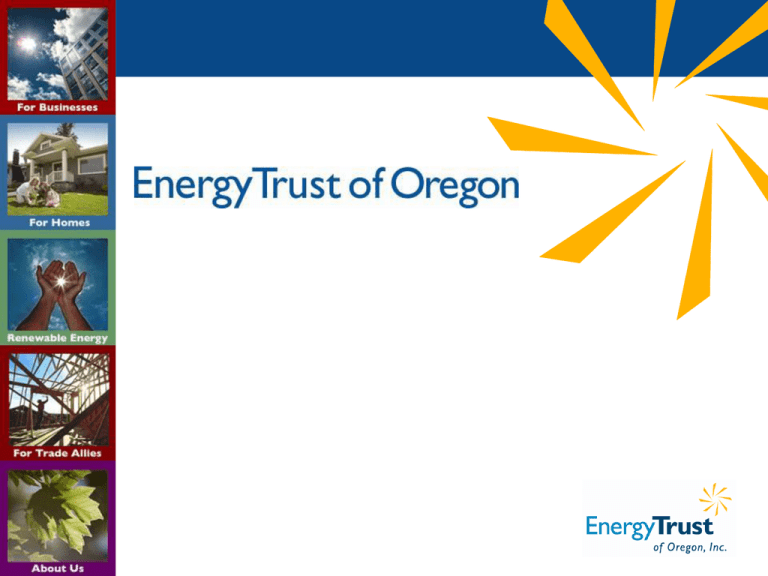Document 17963360
advertisement

A Brief Energy Trust Primer • Product of 1996 Regional Review and 1999 Oregon Legislation establishing a 3% public purpose charge on two electric investor owned utilities • A 501(c)(3) nonprofit organization investing ~$48.5M/year to: – Acquire cost-effective electric efficiency/conservation savings – Contribute up to 100% of renewable energy project above market costs • Separate public purpose charge for residential and commercial customer programs for 3 gas utilities = +$10.4M • ~1.4M Oregon electricity and gas customers with annual savings of 25-28 aMW and 1.2M therms 2 What We Offer • • • • • Stable, consistent funding Comprehensive services Objective energy information Technical information and support Financial incentives 3 Energy Trust Mission To change how Oregonians produce and use energy by investing in efficient technologies and renewable resources that save dollars and protect the environment. 4 Initial 10-Year Strategic Goals 1. Save 300 average megawatts of electricity and 21 million therms of natural gas by 2012 2. Provide 10% of Oregon’s electricity from renewable sources by 2012 3. Expand participation by those previously underserved 4. Support growth of the clean energy industry 5. Encourage Oregonians to incorporate energy efficiency and renewable energy into their daily lives 5 Cumulative Accomplishments • Saved and generated over 1.2 billion kWh of electricity • Saved over 4 million annual therms of natural gas • Generated 16.8 aMW by renewables; +40 aMW online in ‘07 • Served 220,000 consumers • Retrofitted 70,000 residences and 4,000 commercial buildings • Constructed 2,400 Energy Star homes and 440 commercial buildings • Improved efficiency at 570 industrial sites • Installed 1,000 electric and solar water systems • Provided incentives for 95,000 efficient clothes washers • Sold 530,000 CFL packages 6 Organization Structure Oregon Public Utility Commission Policy, Finance, Strategic Planning, and Audit Committees Board of Directors Renewable Resources Advisory Council Conservation Advisory Council Energy Trust Staff Energy Efficiency Renewable Energy Marketing and Communications 7 Planning and Evaluation Finance and Administration Legal and Contracts OPUC Oversight Role • Contracts with Energy Trust • Establishes minimum performance measures • Reviews annual budget, 2-year action plan and 5-year strategic plan • Requires quarterly and annual reports • Requires management audit every 5 years • Liaison to legislature • Ex officio board role • Participates in advisory councils and board strategic planning committee • Can issue a “notice of concern” • Authority to terminate contract 8 Energy Trust Board Role • Independent, non-stakeholder board with volunteer membership – Oregon Department of Energy special advisory seat • • • • • • Fulfills fiduciary responsibilities Establishes policy Determines strategic direction and goals Reviews and approves annual budgets and plans Liaison to advisory councils Prohibited from lobbying 9 Energy Trust Staff Role • • • • • • • • • Conducts strategic analyses Plans for and designs programs Manages staff and contractors Supports trade allies Engages stakeholders Manages finances and incentive payments Ensures quality control and quality assurance Contracts for independent 3-party evaluations Prohibited from lobbying 10 Strength of the Model • • • • • • • • • • Mission focused and driven Stable, consistent funding Comprehensive and integrated services Program management contractor delivery model Trade ally leverage Stakeholder and public involvement High degree of transparency and accountability Measurable outcomes Low administrative costs Utility collaboration 11




